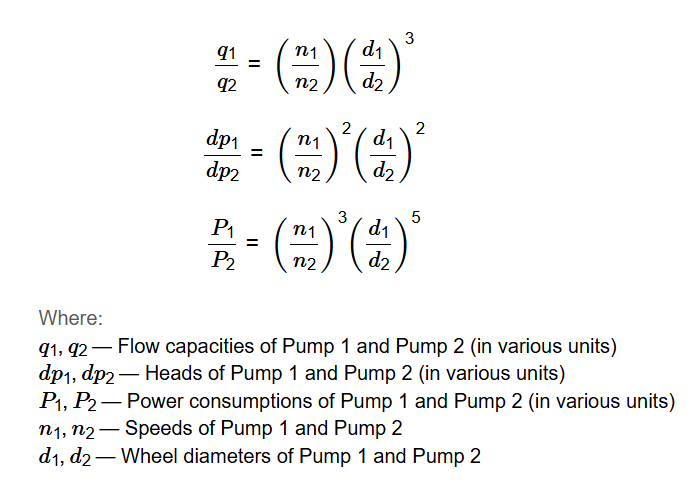 Home
Home
 Back
Back

Definition: This calculator applies the Pump Affinity Laws to compute the flow capacity (\( q_2 \)), head (\( dp_2 \)), or power consumption (\( P_2 \)) of a second pump in a family of geometrically similar pumps, given the parameters of a first pump.
Purpose: It is used in mechanical engineering to predict the performance of a pump based on the performance of a geometrically similar pump, aiding in pump selection, system design, and performance scaling.
The calculator uses the following relationships:
Where:
Explanation: Select the parameter to calculate for Pump 2 (flow, head, or power), enter the corresponding initial value for Pump 1 (flow, head, or power), speeds, and wheel diameters for both pumps in the chosen units. The initial value is converted to its base unit (m³/s for flow, m for head, W for power), speeds are converted to rpm, and diameters are converted to meters. The final value is computed based on the selected affinity law. Results are displayed with 5 decimal places, using scientific notation if the value exceeds 100,000 or is less than 0.0001. For default inputs (\( q_1 = 0.006309 \, \text{m³/s} \), \( n_1 = 1750 \, \text{rpm} \), \( n_2 = 1750 \, \text{rpm} \), \( d_1 = 0.2032 \, \text{m} \), \( d_2 = 0.1524 \, \text{m} \)), the calculated final flow \( q_2 \) is approximately 0.003548 m³/s.
Details: Calculating the performance parameters of a second pump based on a first pump using the Pump Affinity Laws for geometrically similar pumps is essential for scaling pump performance, selecting the right pump for a system, and optimizing energy use in pump applications.
How do I calculate the flow, head, or power for a geometrically similar pump?
Select the parameter to calculate for Pump 2 (flow, head, or power), enter the corresponding value for Pump 1 (flow, head, or power), speeds, and wheel diameters for both pumps in the chosen units. Use the formulas \( \frac{q_1}{q_2} = \left( \frac{n_1}{n_2} \right) \left( \frac{d_1}{d_2} \right)^3 \), \( \frac{dp_1}{dp_2} = \left( \frac{n_1}{n_2} \right)^2 \left( \frac{d_1}{d_2} \right)^2 \), or \( \frac{P_1}{P_2} = \left( \frac{n_1}{n_2} \right)^3 \left( \frac{d_1}{d_2} \right)^5 \) based on your selection.
What do the Pump Affinity Laws for geometrically similar pumps represent?
The Pump Affinity Laws for geometrically similar pumps describe how flow, head, and power consumption scale between two pumps with similar geometry, based on their speeds and wheel diameters, providing a method to predict performance.
What are the formulas for the Pump Affinity Laws for geometrically similar pumps?
The formulas are: \( \frac{q_1}{q_2} = \left( \frac{n_1}{n_2} \right) \left( \frac{d_1}{d_2} \right)^3 \) for flow, \( \frac{dp_1}{dp_2} = \left( \frac{n_1}{n_2} \right)^2 \left( \frac{d_1}{d_2} \right)^2 \) for head, and \( \frac{P_1}{P_2} = \left( \frac{n_1}{n_2} \right)^3 \left( \frac{d_1}{d_2} \right)^5 \) for power, where \( n_1, n_2 \) are speeds, and \( d_1, d_2 \) are wheel diameters.
Can I use different units for flow, head, power, speed, and diameter?
Yes, the calculator supports multiple units for flow (m³/s, gpm, cfm), head (m, ft, Pa, psi), power (W, BHP), speed (rpm, rad/s, Hz), and diameter (m, in). All inputs are converted to their base units for the calculation.
What happens if I enter zero for speeds or wheel diameters?
Entering zero for the speeds (\( n_1 \), \( n_2 \)) or wheel diameters (\( d_1 \), \( d_2 \)) will result in the calculation not being performed, as the formulas involve division by these values. All must be greater than zero for a valid result.